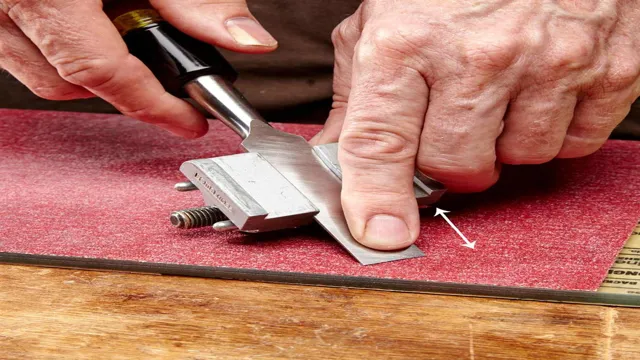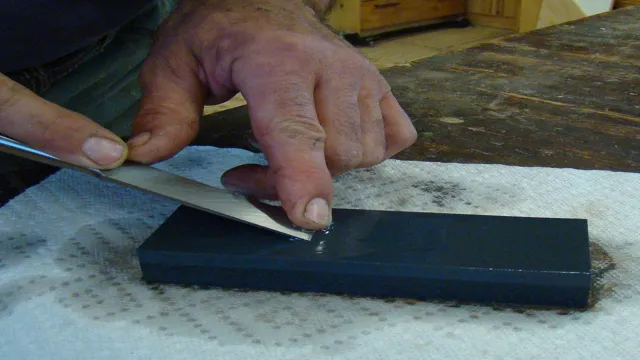Are you tired of using a dull chisel that just doesn’t cut it? Chisels are an essential tool in woodworking, and keeping them sharpened is crucial to getting the job done right. But what sharpening angle should you use? This is a common question among woodworkers, and there isn’t a one-size-fits-all answer. The sharpening angle depends on the type of chisel and the wood it will be used on.
Sharpening angles for chisels typically range from 20 to 35 degrees, with 25 degrees being the most commonly used angle. However, for softer woods like pine or cedar, a lower angle of 20-25 degrees is best, while harder woods like oak or maple require a higher angle of 30-35 degrees. Choosing the right angle can make all the difference in the world when it comes to the performance of your chisels.
But how do you know which one to choose? Don’t worry, we’ve got you covered. In this blog, we’ll explore chisel sharpening angles and give you tips and tricks to ensure your chisels are always sharp and ready for the job at hand. So, let’s get started!
What is a chisel?
A chisel is a woodworking tool used for carving and cutting materials such as wood, stone, and metal. It usually consists of a sharp, flat blade made of steel and a handle that provides grip and control. Chisels come in different shapes and sizes, each designed for specific tasks.
The angle at which a chisel is sharpened is essential to its performance. Most chisels are sharpened at a 25-degree angle, which creates a sharp edge that can easily cut through materials. However, some chisels may have a higher or lower angle depending on the task at hand.
For example, a chisel used for carving intricate designs may have a lower angle to provide better control and precision. Overall, the angle at which a chisel is sharpened is critical to its performance and varies based on its intended use.
Definition and uses of chisels
A chisel is a hand tool consisting of a sharp blade attached to a handle, used for shaping and cutting hard materials such as stone, metal, or wood. Chisels are available in various shapes and sizes, each designed for a specific purpose. For instance, beveled edge chisels are suitable for creating intricate designs in wood, while firmer chisels are best for heavy-duty work like mortising and paring.
Chisels are also commonly used in woodworking and masonry to remove surface fibers or textures. The sharp edge of the tool allows for greater precision in carving, cutting, and shaping, which makes it popular among artisans and craftsmen. Overall, whether you’re a professional or a do-it-yourself enthusiast, a chisel is a versatile tool that will help you achieve a polished, refined look in your projects.

Sharpening angles
If you’re looking to sharpen your chisels, you may be wondering what angle to sharpen them at. The answer varies depending on the type of chisel and the job at hand. For general woodworking, a bevel angle of around 25 degrees is common.
However, if you’re looking for a finer edge, you may want to increase the angle to 30 degrees or more. On the other hand, if you’re working with hardwoods or need a more durable edge, a lower angle of around 20 degrees may be more suitable. Ultimately, the best angle for your chisels will depend on your personal preferences and the specific tasks you’ll be using them for.
Experiment with different angles to find the one that works best for you.
Common chisel sharpening angles
When it comes to chisel sharpening, choosing the right angle is crucial to achieving the best performance. The most common angle for chisels is 25 degrees. However, there are variations to that angle depending on the type of woodwork project.
For example, 20 degrees will work best on delicate jobs that need precise cuts, while 30 degrees is recommended for heavy-duty tasks. It’s essential to note that the angle also varies depending on the type of chisel and the bevel shape. For instance, bench chisels are sharpened at a higher angle than mortise chisels due to their respective uses.
Sharpening your chisels at the correct angle will ensure easier and smoother cutting, and help you achieve precise and accurate cuts. Remember that the angle should remain consistent throughout the sharpening process for the best results.
Factors to consider when choosing a sharpening angle
When it comes to choosing the right sharpening angle, there are a few factors to consider. First and foremost is the type of tool or blade you are sharpening. Different blades and tools require different sharpening angles to achieve optimal sharpness and performance.
Another important factor is the user’s personal preference and experience with sharpening. A more experienced sharpener may prefer a higher angle for a razor-sharp edge, while a beginner may opt for a lower angle for easier sharpening. The material of the blade or tool is also a key consideration, as harder materials may require a higher angle.
Ultimately, finding the right sharpening angle is a balance between these factors and may require some trial and error. Remember, the goal is to achieve an edge that is both sharp and durable for the intended use. So, take your time and experiment to find the angle that works best for you and your tools.
How to sharpen a chisel
If you’re wondering “what angle are chisels sharpened?”, the answer depends on the type of chisel and the type of woodworking you’re doing. Generally, a bevel angle of around 25 degrees is appropriate for most chisels. However, this can vary depending on the wood being worked and the desired level of precision.
It’s also important to keep the chisel sharp as you work, so it’s a good idea to keep a sharpening stone nearby. To sharpen a chisel, start by laying the flat side of the blade on the stone and slowly working it back and forth until you have a uniform bevel. Then, flip the chisel over and repeat the process on the other side.
Repeat this until the blade is sharp, and don’t forget to give the chisel a final polish with a honing compound to remove any burrs. With a sharp chisel and a steady hand, you’ll be able to tackle any woodworking project with ease!
Tools and materials needed
When it comes to sharpening a chisel, there are a few tools and materials you’ll need to have on hand. First and foremost, you’ll need a sharpening stone. Preferably, one with two sides, coarse and fine, so you can sharpen the blade effectively.
Additionally, having a honing guide can be helpful to keep the angle consistent while sharpening, and a flat surface, like a bench or table, is necessary to work on. Another essential item is a strop, which can be used to polish the blade and remove any microscopic burrs left behind after sharpening. You may also want to have some honing oil or water on hand to lubricate the sharpening stone and make the process smoother.
By having all of these materials, you’ll be well-prepared to sharpen your chisel and keep it working effectively for all your woodworking needs.
Step-by-step guide to sharpening a chisel
If you’re new to woodworking, sharpening a chisel might seem like a daunting task. However, with the correct technique and the right tools, it’s actually quite straightforward. The first step is to choose the right sharpening stone – a fine-grit one is best.
Next, make sure your chisel is clamped securely to a workbench or a sharpening jig. Start by honing the bevel edge of the chisel, moving it in a circular motion across the sharpening stone. Once you’ve achieved a flat, polished bevel edge, flip the chisel over and repeat the process on the flat side.
Finally, use a honing guide to angle the chisel and apply a final polishing to the sharp edge. With a little practice, sharpening a chisel can become second nature and will help you achieve clean cuts and precise woodworking.
Safety precautions
When it comes to using chisels, safety should always be your top priority. Before you even begin to sharpen your chisels, it’s important to understand what angle they should be sharpened at. Most woodworking chisels are sharpened at a angle between 25° and 30°.
However, this may vary depending on the type of chisel you are using. For instance, paring chisels may be sharpened at a lower angle of around 20° for fine, delicate cuts. On the other hand, mortising chisels may require a larger angle of up to 35° for heavy-duty work.
It’s important to research and understand the correct angle for each individual chisel type to ensure optimal performance and longevity. Additionally, always wear safety gear such as gloves and eye protection when working with chisels to prevent injuries.
Tips for safe chisel sharpening
When it comes to sharpening chisels, safety should always be the top priority. One of the most important things to keep in mind is to wear protective gear such as safety glasses, gloves, and a dust mask or respirator to protect your eyes, hands, and lungs from debris and dust produced during the sharpening process. Additionally, always make sure your sharpening stone or tool is properly secured and stable to avoid accidents or injuries.
It’s also crucial to keep your fingers and hands away from the sharpened edge of the chisel and to never sharpen a chisel while it’s still in the tool. Practicing caution and taking these safety precautions can help you keep safe while keeping your chisels sharp and ready-to-use.
Conclusion
In conclusion, the angle at which chisels are sharpened can make all the difference in the world. Whether it’s a beveled edge or a honed tip, the right angle can make the difference between a precision cut and a messy mishap. So, just remember to keep your chisels sharp and your angles acute, and you’ll be carving your way to success in no time!”
FAQs
1. What is the standard angle for sharpening chisels? A: The standard angle for sharpening chisels is typically 25 degrees. 2. Can you sharpen a chisel at a different angle? A: Yes, you can sharpen a chisel at a different angle, depending on the specific task you will be using it for. 3. What type of tool is used for sharpening chisels? A: A sharpening stone or a diamond stone is commonly used for sharpening chisels. 4. Should you use oil or water on a sharpening stone when sharpening chisels? A: It depends on the type of sharpening stone being used. Some stones require oil, while others require water. 5. How often should you sharpen your chisels? A: It depends on how often you use them and the type of wood you are working with, but typically chisels should be sharpened after every few uses. 6. What is the best way to maintain a sharp edge on your chisels? A: Regular sharpening and honing, as well as avoiding using your chisels as a screwdriver or pry bar, will help maintain a sharp edge on your chisels. 7. Can you use an angle gauge when sharpening chisels? A: Yes, an angle gauge can be helpful when ensuring consistency in the angle of your sharpened chisels.





